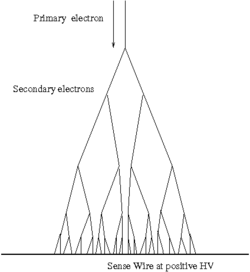Difference between revisions of "TTalks"
Jump to navigation
Jump to search
| (5 intermediate revisions by 2 users not shown) | |||
| Line 1: | Line 1: | ||
| − | [[Media:MiniPrototypeDC_talk_12- | + | [[Media:MiniPrototypeDC_talk_12-04-09.pdf]]<br> |
| + | [[Media:PhysColloqPresentation_1.pdf]]<br> | ||
| + | [[Tamar_Electron_and_Pion_Efficiency]]<br> | ||
| + | [[EG1BFragmentationTestTalk]]<br> | ||
| + | [[File:avalanche.gif|250px]] | ||
| − | [http://wiki.iac.isu.edu/index.php/User_talk: | + | "In a proportional counter, many electrons (10 - 10,000) reach the anode for each primary ion pair produced in the gas. The reason is that the electron of each primary ion pair '''creates''' further "secondary" ion pairs as it gets close to the anode. These secondary ion pairs are produced in what is called an avalanche." [http://www.orau.org/ptp/collection/proportional%20counters/introprops.htm] |
| + | |||
| + | [http://wiki.iac.isu.edu/index.php/User_talk:Didbtama Go Back] | ||
Latest revision as of 04:46, 8 December 2012
Media:MiniPrototypeDC_talk_12-04-09.pdf
Media:PhysColloqPresentation_1.pdf
Tamar_Electron_and_Pion_Efficiency
EG1BFragmentationTestTalk
"In a proportional counter, many electrons (10 - 10,000) reach the anode for each primary ion pair produced in the gas. The reason is that the electron of each primary ion pair creates further "secondary" ion pairs as it gets close to the anode. These secondary ion pairs are produced in what is called an avalanche." [1]
